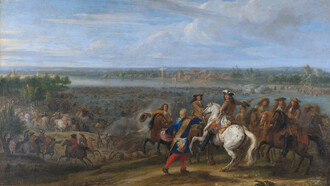Association is the most important (but not the only) pillar of memory. Talking about individual associations of ideas is an abstraction (which, however, we have to do if we want to discuss in this regard) because, in reality, there is almost never a single bond between two thoughts. There is an undetermined number of links between ideas. The concept of mental association in fact is extremely broad.
The elements that make up the concept of association
The concept of association can be interpreted as the “displacement” of an image from one place to another, such as the transit of an image, or a set of images, from the representations that contain it towards the other that “will contain” it. The association is a part of an image that we can put or superimpose onto another and that coincides with it from one aspect or more. Mental association is, therefore, a form of correspondence and its conformity can be total, partial or completely absent. In the first case we have the identity, in the second we have the similarity and in the third we have the opposition. Indeed, identity, similarity and opposition are all elements that make up the concept of association. Moreover, these elements have been connected to the theme of memory from the beginning of philosophical reflection. In Plato’s Phaedo they are clearly defined and expressed in relation to the theme of reminiscence:
Are we also agreed in calling it recollection when knowledge comes in a particular way? I will explain what I mean. Suppose that a person on seeing or hearing or otherwise noticing one thing not only becomes conscious of that thing but also thinks of a something else which is an object of a different sort of knowledge. Are we not justified in saying that he was reminded of the object which he thought of? [1]
Plato’s statement here is very important to understand the art of memory and its evolution. In addition, it is important to highlight the way and the contents with which Plato continues his argumentation:
Does it not follow from all this that recollection may be caused either by similar or by dissimilar objects? – Yes, it does – When you are reminded by similarity, surely you must also be conscious whether the similarity is perfect or only partial. [...] Yes, because we saw that it is possible for the perception of an object by sight or hearing or any of the other senses to suggest to the percipient, through association, whether, there is any similarity or not, another object which he has forgotten. [2]
Starting from perception (sensitivity), Plato emphasizes the analogical process of association; in fact, the similarity between two things is a partial identity. In this passage Plato seems to anticipate the Aristotelian laws of association, but – above all – he puts in relation the thought (and the sensation) of the past with the memory of the present. In fact, is to this “time-parabola” between the past and the present that the first theories of memory have always referred.
Similarity, contrast, contiguity
However, it’s only with Aristotle that there is a formal theory about the four laws of association: similarity, contrast (or opposition), contiguity in space and contiguity in time. It is especially the latter element which properly characterize the mnemonic association.
As already observed, there is no such thing as memory of the present while present, for the present is object only of perception, and the future, of expectation, but the object of memory is the past. All memory, therefore, implies a time elapsed; consequently only those animals which perceive time remember, and the organ whereby they perceive time is also that whereby they remember. [3]
Memory, in a certain specified respect, is the representation of past events in the present. To form memories in the human mind have should be two prerequisites: first, there is a primitive impression, i.e. that there was an impression in sensitivity (perception) to hit our imagination. Second, it must establish a form of connection between the elements to remember. Since the Pegasus is a fictional animal it is impossible that I have perceived it, but I can imagine the animal Pegasus because there are in my mind the primitive images of the wings and the horse. In that sense, we can define fantasy as the ars combinatorial (Combinatorial Art) of the imagination. It is the ability to arbitrarily connect simple images (i.e. reducible to the perception and/or sensation) in complex shapes that have not in previous experience an equivalent objective.
Whenever therefore, we are recollecting, we are experiencing certain of the antecedent movements until finally we experience the one after which customarily comes that which we seek. This explains why we hunt up the series (of kineseis) having started in thought either from a present intuition or some other, and from something either similar, or contrary, to what we seek, or else from that which is contiguous with it. Such is the empirical ground of the process of recollection; for the mnemonic movements involved in these starting-points are in some cases identical, in others, again, simultaneous, with those of the idea we seek, while in others they comprise a portion of them, so that the remnant which one experienced after that portion (and which still requires to be excited in memory) is comparatively small. [4]
This passage highlights a fundamental principle: the association criteria are identical to those of storage or, at least, have the same root. Therefore, knowledge goes from the unknown to the known through the association of particular aspects of the “unknown” that has some resemblance to what we “already know”. The concept of similarity is the most important criterion of association since the other two criteria are, to some extent, derived from it. The “dissimilar” and “contrary” what else are they, but similarities “inverted by sign”? The dissimilar, as the word suggests, is similar in opposition; what is contiguous presents similarities with what precedes and with what follows, and so on.
At the beginning there must be an iconic element, so as to make an analogical connection between the unknown thing and another that is already part of our “knowledge”; we take the latter as a pivot in order to understand the first. So the mnemonic association must restore this pre-logical process of union. The typical association of the art of memory is, therefore, not only a logical association but also an analogical one. The main effort of the mnemonist is, therefore, not only a proper intellectual (rational) but rather a de-abstraction mental exercise, an effort to bring the abstract associations (that are in this way for linguistic convention, or for formal and logical reason, etc.) into an iconic-analogical union; a constant effort to keep the level of imagination.
Expanding the Aristotelian classification reported earlier, the methods for organizing knowledge (and thus the memories) are these: 1) similarity both real and metaphorical; 2) continuity (increase, decrease, grading scales, etc.); 3) contiguity (crying, tears); 4) relationship (milk-butter); 5) logical induction; 6) logical deduction; 7) relationship cause and effect; 8) contrast and/or opposition; 9) figures of speech (metaphor, metonymy, synesthesia, analogy etc.); 10) rhythm of the music, which one of poetry, of the prose, etc.; 11) assonance; 12) sensory memory (a sound, a smell etc.); 13) etymological root of the words; 14) rhyme; 15) the nursery rhyme etc.
Specific consideration should be devoted to the cause and effect relationship. In everyday life we are led to establish causal relationships between events continually, especially if these occur in succession. This type of cause and effect relationship, however, is almost never based on real and rational elements, but on the way we perceive situations and on our mental schemes and our deeply held beliefs. This cause-effect bond is founded in our imagination and it is very strong. In this regard, the “cause-effect bond” is a form of contiguity in time and/or space enhanced. It is even stronger than the association by similarity since it does not require any similarity between cause and effect, but only that the effect follows the cause.
Kinds of mental association
In the art of memory we should always pay attention to link word to word, word to image, image to image; all this at least theoretically. However, when effectively we are going to memorize, we proceed – so to speak – mechanically in such a way that we are not always aware of the type of mental associations we create. Sometimes we act only on the words, without evoking images, or without paying attention to the images that our mind spontaneously evokes.
Therefore, it may be necessary to present here a classification of the main types of mnemonic associations that I call a parallel classification of mental associations: 1) association between image and concept; 2) association between image and image; 3) association between abstract concepts and abstract concepts. The role played by the imagination in points 1 and 2 is fairly easy to understand, while it is more difficult to define the use of mental images when you associate concepts that are in themselves abstract. The most “natural kind” of association is between image and image and this is the way with which things are imprinted more easily in memory. The link between abstract concepts, on the contrary, is weaker and it is the one that needs the most help from the mnemonic images. When we associate with abstract concepts, we should always try to fit between them at least one image to help us to remember better.
The mnemonic associations can also be categorized with respect to their modality: sensory (we can remember a thing from the smell, sound, etc.), emotional (emotion reminds us of a situation associated with it, and vice versa), logic (from a defined series of images “inducing” another; from a concept “deducing” another) and by a combination of all these factors.
One last, but fundamental remark: the classifications shown here are purely for exposure value; in our mental reality, we can’t isolate images from other thoughts and/or images from abstract concepts. They refer to each other, they imply, exchange, mix, hiding one behind the other, and vice versa. The image, an image in its purest form, without any symbolic reference, is the simple perception... and perhaps not even that.
[1] Plato, Phaedo, 74
[2] Plato, Phaedo, 76
[3-4] Aristotle, De memoria et reminiscenza















